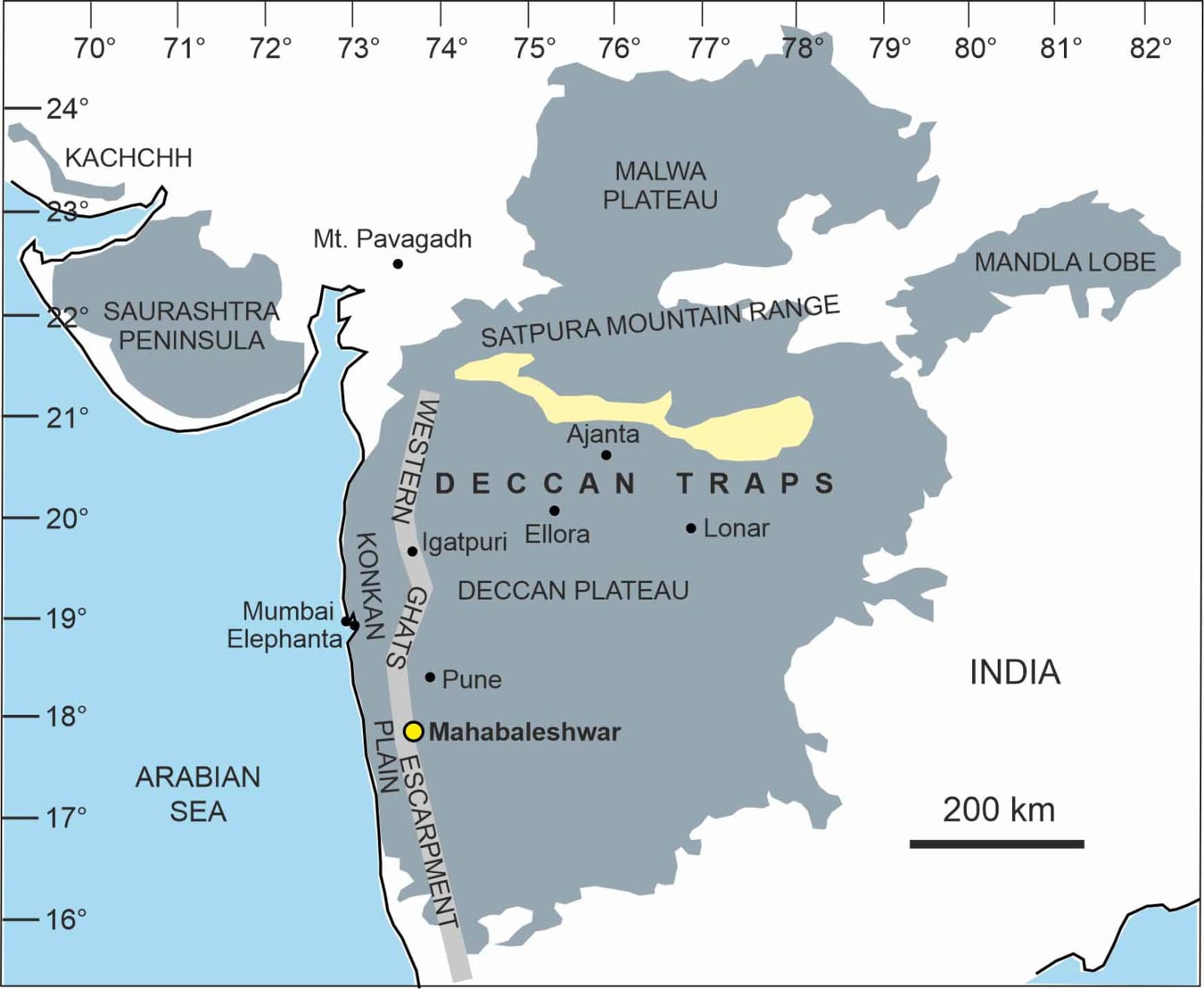The Deccan Trap is one of the world’s largest volcanic provinces, formed by massive volcanic eruptions around 66 million years ago. Spanning approximately 500,000 square kilometers, it covers large parts of Maharashtra, Madhya Pradesh, Gujarat, Karnataka, Telangana, and Andhra Pradesh. The Deccan Trap is not only a geological marvel but also a region of immense natural resource potential, which has played a crucial role in India’s economic development and continues to offer new opportunities for sustainable growth.
This article provides a comprehensive analysis of the natural resource potentials of the Deccan Trap, structured to meet the requirements of UPSC Civil Services aspirants. It covers mineral, soil, water, energy, forest, and biodiversity resources, along with their economic significance, challenges, and prospects for sustainable development.
Geological Background of the Deccan Trap
- Formation: The Deccan Trap was formed by successive outpourings of basaltic lava during the late Cretaceous period. The solidified lava created a step-like plateau, giving the region its characteristic “trap” (from the Swedish word for stairs) topography.
- Extent: It is one of the world’s largest continental flood basalt provinces, with thicknesses exceeding 2,000 meters in places.
- States Covered: Maharashtra, Madhya Pradesh, Gujarat, Karnataka, Telangana, Andhra Pradesh, and parts of Chhattisgarh and Rajasthan
Mineral Resources
1. Basalt
- The primary rock type, basalt, is extensively quarried for use in construction—roads, railways, bridges, and buildings—due to its durability and compressive strength.
- Basalt is also used as an aggregate in concrete and as decorative stone in architecture.
2. Bauxite
- Weathering of basaltic rocks has led to the formation of significant bauxite deposits, especially in Maharashtra (Kolhapur, Satara), Gujarat, and parts of Odisha.
- Bauxite is the principal ore of aluminum, vital for industries such as aviation, packaging, and electronics.
3. Iron Ore and Manganese
- The Deccan Trap region, particularly in Maharashtra (Vidarbha) and Chhattisgarh (Durg-Bastar), contains iron ore deposits, often associated with laterite formations.
- Manganese is also found, crucial for steel production and battery manufacturing.
4. Copper
- The Balaghat region of Madhya Pradesh within the Deccan Trap is known for copper deposits, supporting electrical, electronics, and industrial machinery sectors
5. Other Minerals
- Limestone and Dolomite: Used in cement and steel industries, found in regions like Chandrapur (Maharashtra).
- Quartz and Silica: Used in glass and ceramics industries.
- Zeolites: The Deccan Traps are globally renowned for zeolite minerals, formed in basalt cavities and valued for industrial and scientific uses.
- Semi-precious Stones: Agates, jaspers, and zeolites are found in the cavities of basaltic rocks, supporting local gemstone industries.
6. Hydrocarbon Potential
- Petroleum and natural gas reserves have been identified in deeper sedimentary basins beneath the basalt layers, particularly in the Saurashtra and central India belts, though large-scale extraction remains limited.
- Ongoing exploration may reveal further hydrocarbon resources in the future
Soil Resources
1. Black Soil (Regur Soil)
- The Deccan Trap is famous for its black cotton soil, formed by the weathering of basalt.
- Characteristics:
- High clay content and moisture retention.
- Rich in iron, lime, magnesium, and aluminum.
- Swells when wet and shrinks upon drying, causing deep cracks.
- Agricultural Significance:
- Ideal for cotton, sugarcane, pulses, oilseeds, and cereals.
- Supports India’s leading cotton and sugarcane belts, especially in Maharashtra and Gujarat.
2. Laterite Soil
- Found on the plateau’s higher reaches, laterite soils are rich in iron and aluminum oxides.
- Suitable for plantation crops like tea, coffee, and cashew in regions with higher rainfall
Water Resources
1. Surface Water
- The Deccan Trap is drained by major peninsular rivers: Godavari, Krishna, Narmada, and Tapi.
- Major Dams:
- Sardar Sarovar (Narmada)
- Nagarjuna Sagar (Krishna)
- Jayakwadi (Godavari)
- Koyna (Maharashtra)
- These rivers and dams provide irrigation, drinking water, and hydroelectric power, supporting agriculture and industry.
2. Groundwater
- The fractured and porous nature of basaltic rocks creates excellent aquifers, crucial for storing and transmitting groundwater.
- Groundwater is vital for irrigation, especially in drought-prone regions like Marathwada and Vidarbha.
- However, over-extraction and irregular rainfall can lead to groundwater depletion, requiring careful management.
3. Challenges
- Hard rock terrain limits groundwater recharge rates.
- Seasonal rivers and erratic monsoons can cause water scarcity in some areas.
Energy Resources
1. Hydroelectric Power
- The elevation changes and perennial rivers make the Deccan Trap ideal for hydroelectric projects.
- The Koyna Hydroelectric Project in Maharashtra is one of India’s largest, providing significant renewable energy.
2. Geothermal Energy
- The residual heat from ancient volcanic activity offers geothermal energy potential, with hot springs identified in the Konkan geothermal province (Unhavare, Tural, Aravali).
- This resource remains underutilized but holds promise for future sustainable energy development.
3. Wind and Solar Power
- The plateau’s topography and climate offer excellent prospects for wind and solar energy generation.
- Districts like Satara (Maharashtra) host major wind farms, contributing to India’s renewable energy mix.
Forest and Biodiversity Resources
1. Forests
- The Deccan Trap supports tropical dry deciduous forests, with dominant species like teak, Hardwickia, and bamboo.
- Forests provide timber, fuelwood, medicinal plants, and non-timber forest products.
2. Wildlife
- The region is home to rich biodiversity, including tigers, wild buffalo, wild dog, four-horned antelope, gaur, blackbuck, and chinkara.
- Protected areas and wildlife sanctuaries help conserve this biodiversity, supporting eco-tourism and research.
Other Resource Potentials
1. Carbon Sequestration
- Basaltic rocks in the Deccan Trap have the potential to sequester carbon dioxide, offering a natural solution for climate change mitigation.
2. Tourism
- The unique landscape, ancient cave temples (e.g., Elephanta Caves), and geological features attract tourists, supporting local economies.
Economic and Strategic Importance
- The Deccan Trap’s resources underpin major sectors: agriculture, construction, steel, aluminum, cement, energy, and tourism.
- The region’s mineral wealth supports India’s industrialization and export potential.
- Fertile soils sustain millions of farmers and contribute to national food security.
- Hydroelectric and renewable energy projects reduce dependence on fossil fuels and help meet climate goals.
Challenges in Resource Utilization
- Ecological Sensitivity: Mining and resource extraction can threaten fragile ecosystems and biodiversity.
- Water Scarcity: Hard rock terrain and seasonal rivers limit water availability, requiring efficient management.
- Soil Degradation: Overuse of chemical fertilizers and unsustainable farming can degrade soil health.
- Mining Difficulties: Deep weathering, landslides, and inaccessible terrain complicate mineral extraction.
- Climate Change: Irregular rainfall and rising temperatures affect agriculture and water resources.
Sustainable Development and Future Prospects
1. Balanced Resource Management
- Promote responsible mining, afforestation, and soil conservation to minimize ecological impacts.
- Encourage rainwater harvesting and groundwater recharge to address water scarcity.
2. Renewable Energy Expansion
- Invest in wind, solar, and geothermal energy to diversify the energy mix and reduce carbon emissions.
3. Value Addition and Local Industries
- Develop downstream industries (e.g., aluminum smelting, steel production, agro-processing) to generate employment and boost regional economies.
4. Eco-Tourism and Heritage Conservation
- Leverage the region’s geological and cultural heritage for sustainable tourism, benefiting local communities.
5. Research and Innovation
- Support geological and environmental research to discover new resources and improve extraction technologies.
The Deccan Trap is a treasure trove of natural resources, encompassing rich mineral deposits, fertile soils, abundant water (though unevenly distributed), renewable energy potential, forests, and biodiversity. These resources have shaped the region’s economic and social landscape and will continue to be central to India’s developmental trajectory. However, sustainable management is essential to balance economic growth with ecological preservation, ensuring that the Deccan Trap’s natural wealth benefits present and future generations.





0 Comments